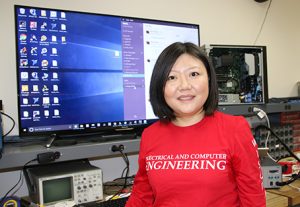In the ultracompetitive Wild West of AI, a new generation of pioneers is emerging.
Armed with the Cloud and a mission to push the limits of deep learning, Jing Li and her team of student “hackers” have bested industry titans and set a performance record.

The robot in Jing Li’s laboratory does not look like one, she admits.
“My student wanted to design something to replace himself.” She gestures to an unimposing circuit board on the bench top. “This does his work collecting data and doing analysis, and sends it to his email 24-7.”
A conversation with Professor Li – a rising star in the department of electrical and computer engineering – can take many turns.
Immersed in the complex world of neural networks, she has an uncommon ability to see the big picture (“In 10 years maybe we scale an entire data center into one cell phone”), to approach systems holistically (“We have to optimize both algorithm and architecture”) and frame the social implications of research (“Like everything, AI has two sides”).
With support from the WARF Accelerator Program, her latest project is developing a deep learning accelerator in the Cloud. The goal: faster, smarter and more energy-efficient systems for deep learning, with applications like improved speech recognition.
WARF is funding the prototyping effort, using a versatile ‘DIY’ type of chip called a field-programmable gate array (FPGA) as a platform.
FPGA research is hot right now as giants like Microsoft and Amazon look to accelerate the performance of certain critical applications in their data centers.
“We are using FPGA offline to demonstrate that this can be directly transferred to all Cloud providers with no cost,” she says.
Li’s research program at UW has a common thread. In simplest terms, she is striving “to put more and more computing power into single devices, to make them smarter and more intelligent.”
Li, who worked at IBM for five years before accepting a position at UW–Madison, does not regret her venture into academia. She thrives on the freedom. And the old view – that universities lack the tools to compete with industry – no longer holds true.
“When we are hitting the walls – hitting the physical limits – the entire computer and IT industry is no longer driven by Moore’s Law. More innovation is needed.
“We can no longer just do transistor scaling and have a better generation of computers,” she says. “To squeeze the last juice out of silicon, we really have to think how we can offload some of the mission critical applications through hardware-software co-design.”
She says that WARF funding, talented graduate students and access to Catalyst mentors help her stay nimble in a field that is changing faster than at any time in history.
“When I have an idea I don’t have to wait to join Intel and work with thousands of engineers to make it happen,” she says. “WARF is one of the key differentiators of our school compared to others.”
Her recent experience at a top FPGA conference illustrates the point. Rubbing shoulders with the likes of Microsoft and Amazon, it was Li’s presentation that got many people talking.
“It’s hard to believe,” she laughs. “Some of the companies there have hundreds of engineers working on the same thing. We have just two – me and my student [Jialiang Zhang].”
Their preliminary results related to performance and energy efficiency were beyond impressive. They set a world record.
“We are not just building a toy example to make academic people excited,” she says. “A lot of industry people are excited too.”
The spotlight has shone on Li throughout her career. An award-winning student in Shanghai, she attended Purdue University where she mastered English by taping lectures.
An IBM Ph.D. fellowship took her to New York and she would go on to work for the company – one of only two women among 200 researchers in her particular department. There, Li’s work on phase-change memory brought her recognition.
In 2015 Li landed on campus and in short order received a national DARPA Young Faculty Award.
Incredibly, Li did not own a computer until she was 14 years old. It was a gift; her parents had saved a long time.
“At that time it was very rare for a family to have a computer,” Li told Madison Magazine last year. “It was precious, like a treasure.”
Today, thriving in her role as a researcher and educator, Li shares with her students a pearl of wisdom from her mentor back at IBM.
“What we really need right now is vertically integrated research, with people able to work across the system stack,” she says. “One of the barriers is our educational system – we teach different classes and don’t have a single class to make it connected. Research is about connecting the dots.
“I always tell my students, looking down is great for addressing every problem to the tiny details. But over time, you also have to learn to look up.”